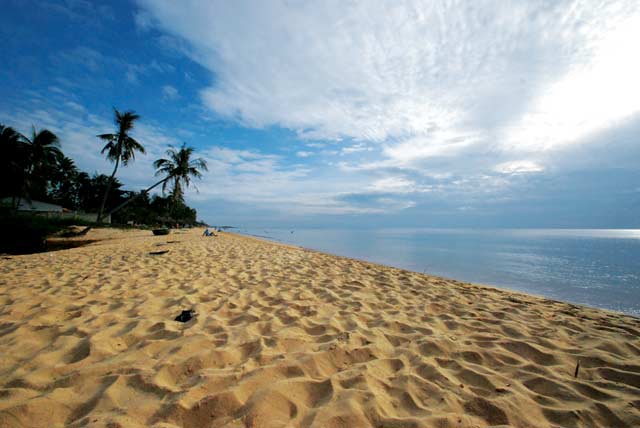The island of Phu Quoc has enchanted independent travellers for years. What does the future hold for this teardrop in the Gulf of Thailand?
By Simon Hare
Mother Nature was certainly in a generous mood when bestowing her gifts on the Vietnamese island of Phu Quoc. Dense green rainforest cloaks the 99 peaks running along the island’s spine, like the ridges on the back of a mythical dragon, and is home to a stunning array of plants and wildlife: endangered orchids, eagles and falcons; and species such as the Bengal slow loris, the Asian small-clawed otter and the great hornbill.

This tropical arcadia tumbles down gentle slopes to a string of sandy beaches, remote coves and clear waters that guard an equally diverse bounty of coral reefs, sea grass meadows and myriad creatures including turtles, seahorses and the elusive dugong – a huge, seal-like creature minus the endearing face.
Amongst these rare species is the rather more ubiquitous Phu Quoc hunting dog. With its pronounced ridgeback, curly tail and blue tongue, it is a loyal beast that has inspired many myths on the part of the locals. Allegedly unable to thrive anywhere other than Phu Quoc, it is also claimed that the breed is capable of capturing its master’s scent from over a kilometre away.
Visitors will be delighted at possessing a slightly less refined sense of smell should they choose to visit the fish sauce factory in the island’s capital Duong Dong. Phu Quoc is famous for producing a particularly fine version of the Southeast Asian staple, known locally as nuoc mam. A three-metre ladder even provides a chance for advanced stench snooping – by peering inside a giant vat of the slowly fermenting condiment.
Also in Duong Dong, the gaudily painted Cao Dai temple provides an interesting introduction to one of the region’s more idiosyncratic religions. Caodaiism is based around the ‘three teachings’, each representing a different level of spiritual attainment. ‘Saints’ such as Jesus, Buddha and Mohammed are revered by Caodaiists, with less likely ‘holy spirits’ such as Thomas Jefferson, Martin Luther King and Lenin a few rungs lower on the ladder of enlightenment but nonetheless revered inside
the temple.
A darker experience awaits at the Phu Quoc Prisoner of War museum. Many locals believe that tales of execution and torture carried out by South Vietnamese soldiers on their northern counterparts are pure fabrication, but the museum documents explicitly the fate of thousands of prisoners over the centuries. The ‘tiger cage’ displayed on the museum’s grounds – a small, barrel-shaped cage of barbed wire where prisoners would be left naked to burn in the midday sun – seems to verify this idyllic island’s bleaker times.
Alongside Phu Quoc’s more abstruse attractions is the staple fare of tropical island life. Mile upon mile of deserted beaches beg inspection and relaxation, a jungle-clad interior taunts obstinate adventurers, while traditional fishing villages dot the coast, vivid colours splashed here and there by the numerous boats waiting to take to the waves.
Accommodation options were once limited, but are beginning to run the gamut. The most affordable options remain clustered around the northern end of Long Beach, which stretches for some 20 kilometres along the western coast, while luxurious resorts to the north of the island can command nightly rates of up to $500.
For so long the island’s relative inaccessibility, despite its location only 12 kilometres southwest of Kampot in Cambodia, had kept visitor numbers at manageable levels. Just 80,000 foreign tourists were recorded in 2011, but as visitors fly into the island’s tiny airport, a giant gash in the luxuriant green is clearly visible where the new $810m international airport is nearing completion. A second scar cuts through the forest to make way for a multi-lane highway. Targets for tourist growth are set at a staggering three million visitors to the island by 2020.
A recent report in The New York Times described Phu Quoc as “the next Phuket”, a comparison that may sound attractive economically but one that is alarming environmentalists, traditionalists and independent travellers.
A visit to Long Beach in high season offers a glimpse of what could become of this jewel of an island if further development is not properly managed. The once celebrated beach is fast disappearing as hotels creep towards the water’s edge in subtle land-grabs; whining jet skis and pounding music shatter the silence; and the island’s fabled dogs happily use the beach as playground, boudoir, battlefield and toilet.
Elsewhere, illegal logging threatens endangered animal habitats, careless divers gradually eat away at coral reefs, and over-fishing to satisfy the increasing demands of the fish sauce industry is depleting marine stocks.
For now, however, development has slowed. The new airport is still on schedule to open later this year, but payments to contractors building the highway have dried up, leaving an unfinished road and bulldozers standing idle at its side. The island still awaits connection to the cheaper national electricity grid, meaning many investors are biding their time before committing significant cash.
These delays may prove to be nothing more than a temporary stay of execution, but it seems that Phu Quoc has reached a fork in the road. Will it become another tale of a long-gone ‘untouched Asia’ spouted by sentimental travellers, or one of the tourism industry’s great missed opportunities? The island, when seen from the air, is said to be shaped like a teardrop. The next couple of years could reveal from where it was shed.
